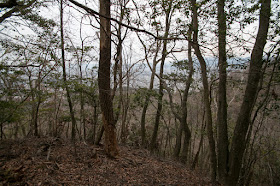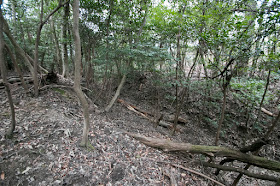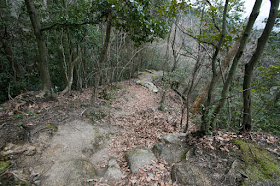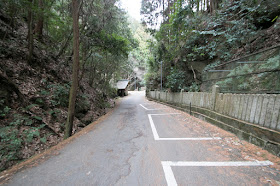Kita Shirakawa Castle
-Time to treason (3) protection of capital city and Shogun-
Overview
Name: Kita Shirakawa castle (Kira Shirakawa-jo)
Alias: Shogunyama-jo, Uryu-yama-jo (Shogunyama castle, Uryu-yama castle)
Place: Ichijoji Sakyo-ku, Kyoto city, Kyoto
Type: Mountain Castle
Built: 15th century
Remaining remnants: Clay walls and moats
Title:
Brief History
Continued from Part 2
Kita Shirakawa castle (北白川城) is built over Uryu-yama mountain, one of about 200 meter height from hillside at the northeast of Kyoto basin. Uryu-yama mountain exist at the middle part of Higashiyama hills, which prolongs 5 kilometer southward from Hieizan mountain and forms eastern border of Kyoto basin.
Castle site is an important place of communication as it is the exit of Yamanaka-goe road, which crosses Higashiyama hills and runs toward west coast of Lake Biwako and Hokuriku area where economically prospered. In addition to this, Uryu-yama itself is suitable for castle as its backside is separated by the valley of Shirakawa and connected to backside mountain by only narrow ridge, and it has radial many ridges then could built many terraces.
Origin of Kita-Shirakawa castle
Precise year is unknown but Kita Shirakawa castle might be built as genuine castle at the beginning of 16th century. Historically there had been no permanent castle at the flat area of Kyoto basin before 16th century, as the capital was nominally held by the Emperor and even Shogunate had to consider it. Furthermore, there was no large vacant space to build a castle.
However, powerful person of the era had to secure themselves, thus they built many temporal or permanent castle at surrounding mountains. At first mountain temples already existed were turned into castles, but later genuine castle were built. As north side mountains are high and connected only to mountainous area, and capital are spreads east half of the basin, east side mountains had many castles.
In 1493, Masamoto Hosokawa (1466-1507), the leader of Hosokawa clan which virtually won the battle of Onin and became the highest retainer of Shogunate, carried out coup d’?tat and forcibly changed the Shogun of Muromachi Shogunate. This is called as the political incident of Meio and recognized as the start of turbulent era.
Struggle for Shogun position
Under Yoshizumi Ashikaga (1481-1511), the 11th Shogun at their side, Hosokawa clan seized the power of Shogunate and became the highest authority. But Masamoto was killed by the conflict for successor, and the power of Hosokawa clan gradually declined by internal conflicts.
On the other hand, Yoshitane Ashikaga (1466-1523), who was expelled from Shogun by Hosokawa clan, wandered over 13 years and asked for assistance to strong governors to return to Shogun. Now Ashikaga clan divided into two lines and started to conflict for the place of Shogun.
In 1508, Yoshitane returned to Kyoto city being assisted by Ouchi clan, the governor of Suo and Nagato province (Yamaguchi prefecture). Yoshizumi Ashikaga escaped to Omi province where Rokkaku clan governed. Yoshitane seek the chance for recovery but it did not realize and died there.
Division of Muromashi Shogunate
However, it was a burden for Ouchi clan to stay its army long time at distant place, then Ouchi clan returned to their territory in 1518. Without the support of Ouchi clan, Yoshitane who lacked the military power was also involved into the internal conflict of Hosokawa clan thus had to leave Kyoto city. Yoshitane lived at Awaji island and also died there.
As a result of weakening of Hosokawa clan, Muromachi Shogunate was separated into the line of Yoshizumi, including 12th Shogun Yoshiharu Ashikaga (1511-1550), 13th Shogun Yoshiteru Ashikaga (1536-1565), 15th Shogun Yoshiaki Ashikaga (1537-1597) being supported by Rokkaku clan, and 14th Shogun Yoshihide Ashikaga (1538-1568) under Miyoshi clan which was the lord of Awa province (Tokushima prefecture).
Under its leader Nagayoshi Miyoshi (1522-1564), Miyoshi clan gradually expanded its power and built their own virtual Shogunate at Sakai city. In response to this, Rokkaku clan cooperated with remaining Hosokawa clan or Hatakeyama clan to defeat Miyoshi clan. Rokkaku clan marched into Kyoto city with Yoshiharu Ashikaga or Yoshiteru Ashikaga, then built castles at Higashiyama hills to connect Kyoto city and their territory including Kita Shirakawa castle.
Refuge and return of Shogun
In 1558, Yoshiteru Ashikaga and Rokkaku army attacked Kita Shirakawa castle already captured by Miyoshi army. In response to this, Miyoshi army deprived Nyoigatake castle at neighbor place then faced each other. But as Miyoshi army had large soldiers, both side made peace then Yoshiteru returned to Kyoto city as Shogun but approved the hegemony of Miyoshi clan in 1558.
This stability continued for five years, but Miyoshi clan lost its power by losing its Nagayoshi and other leaders then Yoshiteru activated to regain his power. But this arouse the antipathy of remaining Miyoshi and its retainer Matsunaga army, thus in 1565 Yoshiteru was assassinated by Miyoshi and Matsunaga army. His younger brother Yoshiaki Ashikaga escaped from Kyoto city and wandered asking for assistance.
In 1568, Yoshiaki Ashikaga returned to Kyoto city under the assistance of Nobunaga Oda (1534-1582), the warlord of Owari province (western half of Aichi prefecture). Yoshiaki became 15th Shogun, and Mitsuhide Akechi (1528-1582) who coordinated Yoshiaki and Nobunaga became the retainer of both after long unemployment period.
Protection from remaining old power
But at the beginning of 1569, Miyoshi army once returned to Shikoku island ascended to Kyoto area again and attacked Yoshiaki who stayed Honkokuji temple near current Kyoto station. Oda army had only small guards and it looked Yoshiteru might be also assassinated same as his brother.
However, Oda army stubbornly resisted against the attack of Miyoshi army. According to the tale, Mitsuhide activated at this battle firing matchlock guns to the enemy. In the mean time, Nobunaga rushed from his main base Gifu castle (Gifu prefecture) to Kyoto city passing snowy road, then broke Miyoshi army.
To keep the source of his authority, Nobunaga decided to build secured residence for Yoshiaki. Also Yoshiaki might reform mountain castle formerly used by Ashikaga Shogunate to escape in case of emergency. Kita Shirakawa castle might be improved around this time.
Structure of Kita Shirakawa castle
Central area of Kita Shirakawa castle is a roughly rectangular one of 50 meter long and 20 meter wide, has a clay basement of watchtower at is backside. At the west of central area, two lines of terraces are built along with the ridges which are separated into small terraces of about 10 meter long.
East of the central area where is at the backside of the castle are consist of large terraces in contrast. Two layers of terraces partially protected by clay wall are built at the slope, and straight lined dry moat are built between outer area. This part is more advanced and technical then might be added later.
Outside of the castle, several front forts are built over eastward ridge connected to main body of Higashiyama hills. These front forts have further technical structure and clear will to shut the road, and might be built at the battle against Asakura and Azai army. Total size of core part is about 250 meter long and 200 meter wide, and including outer fort it exceeds 500 meter long.
Break with Asakura and Azai clan
Close relationship of Yoshiaki and Mitsuhide continued only one year. Yoshiaki tried to control by himself, and this was opposite of the will of Nobunaga who thought Yoshiaki just a symbol. Nobunaga forced 9 rules to restrict the action of Yoshiaki, and the relation between two parties became worse but still remained.
In 1568, Nobunaga ordered Yoshikage Asakura to visit Kyoto city and assist the construction of new castle for Yoshiaki, but Yoshikage declined this. Looking this as disorder to Yoshiaki and Nobunaga, Nobunaga lead his army and attacked Asakura clan. But Nagamasa Azai (1545-1573), a younger brother in law of Nobunaga but owes to Asakura clan, turned to Asakura clan and shut the backside of Nobunaga.
Nobunaga barely returned from Echizen province, placing Mitsuhide Akechi and Hideyoshi Kinoshita (1537-1598, later Hideyoshi Toyotomi) as rear guard. Nobunaga soon prepared for next attack to Asakura and Azai army then broke them at the battle of Anegawa but both armies still remained then ascended to Hieizan temple just at the north of .Kyoto city.
Crisis of Oda goverment
Next Nobunaga attacked remaining Miyoshi army at Settsu province (middle part of Osaka prefecture), but this excited Ikko Ikki army at Ishiyama Honganji temple (current Osaka prefecture) then Ikko Ikki army suddenly raised and attacked Nobunaga from backside. Now encirclement of Nobunaga by Asakura and Azai army, Miyoshi army and Ikko Ikki army started.
At this time Mitsuhide protected Kita Shirakawa castle with Yoshinari Mori (1523-1570), who was the commander of Usayama castle at the opposite of Yamanaka-goe road, to prevent invasion of Asakura and Azai army to Kyoto city from Hieizan mountain.
Yoshinari Mori who faced overwhelming enemy died in the battle, but Usayama castle which was enhanced by stone walls barely survived before attack of Asakura and Azai army and prevented entrance of enemy into Kyoto city. In the meantime Nobunaga turned his enemy to Kyoto city, and faced Asakura and Azai army.
Afterward of castle
Kyoto city was barely kept, but Nobunaga could not attack Asakura and Azai army stayed at higher Hieizan mountain and had to stay there, then in the meantime Nobunaga lost his younger brother stayed at Owari province by the attack of local Ikko Ikki army.
Finally at the arrival of winter, Nobunaga temporally agreed with Asakura and Azai army which feared the effect of heavy snow. Losing many important people Nobunaga barely survived crisis, and prepared for counter attack to enemies. Nobunaga placed Mitsuhide at Usayama castle (Shiga prefecture), preparing for Hieizan Enryakuji Temple which was critical to the security of Kyoto city.
After the destruction of Hieizan Enryakuji Temple next year the castle might be abolished. Now no building exists but structure of the castle well remain over the mountain and used as trekking course. Several ruins of the castle built at different period shows fierce battles of the lords aiming capital city, and tough situation of Shoguns involved in such conflicts.
Continue to Part 4
Access
30 minutes drive from Meishin Expressway Kyoto-Higashi interchange to Tanukidanisan Fudoin Temple. 20 minutes walk from entrance at the backside of Tanukidanisan Fudoin Temple to hilltop castle.
Related Castles
Tsumagi castle -Time to treason (2) tough job search with wife-
Usayama Castle -Time to treason (5) bearing worst crisis-
Usayama Castle -Time to treason (5) bearing worst crisis-











































































































































































































No comments:
Post a Comment